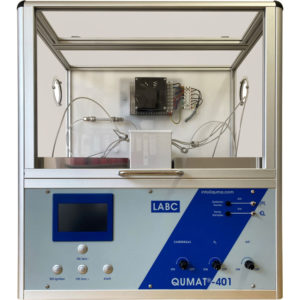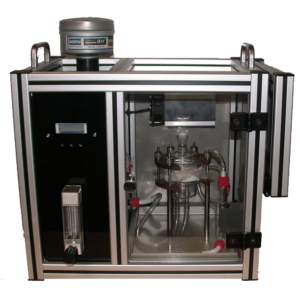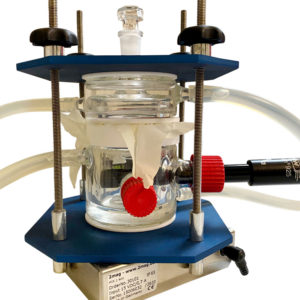Field of application is the research of personal protective equipment (PPE)
- The transport of a substance through personal protective equipment (PPE) to human skin (permeation) should be prevented by wearing PPE.
- A maximum wearing time depends to a significant extent on the resistance of the personal protective equipment (PPE) to the respective hazardous substance and the type of activity performed.
- Chemical protective gloves and clothing must therefore have a minimum temporal resistance to the invisible penetration (permeation) of chemicals in accordance with their practical use.
- This resistance is simulated according to the test method of the standards EN 16523-1:2015-04 and EN 16523-1:2015-04 (formerly DIN EN 374-3) by determining the breakthrough time experimental.
- The large number of chemical substances, the mandatory recommendation of a suitable PPE material in a chemical safety data sheet, and even the smallest changes in the PPE material composition during manufacture require a large number of permeation tests.
LABC-Labortechnik develops permeation workstations for the standardized performance of meaningful measurements. The standards EN 16523, EN 374, EN 6529 and F-739.
The standards specify lists of test chemicals, known as permeation chemicals. In addition, the appropriate measurement method is given for each permeation chemical. As a rule, the lists are included in the informative annex.
The three different analytical instruments of LABC-Labortechnik cover all permeation chemicals.
List of test chemicals in normative Annex A of EN 374-1:2016
| Test Chemicals: | CAS: | LABC Analyzers: | ||||
|---|---|---|---|---|---|---|
| A | Methanol | 67-56-1 | x | x | ||
| B | Acetone | 67-64-1 | x | x | ||
| C | Acetonitrile | 75-05-8 | x | x | ||
| D | Dichloromethane | 75-09-2 | x | |||
| E | Carbon disulfide | 75-15-0 | x | |||
| F | Tuluol | 109-88-3 | x | x | ||
| G | Diethylamine | 109-89-7 | x | x | ||
| H | Tetrahydrofuran | 109-99-9 | x | x | ||
| I | Ethyl acetate | 141-78-6 | x | x | ||
| J | n-Heptane | 142-85-5 | x | x | ||
| K | Sodium hydroxide 40 | 1310-73-2 | x | |||
| L | Sulfuric acid 96 % | 7664-93-9 | x | |||
| M | Nitric acid | 7967-372 | x | |||
| N | Acetic acid 99 | 64-19-7 | x | x | x | |
| O | Ammonia water 25 | 1336-21-6 | x | |||
| P | Hydrogen peroxide 30 | 7722-84-1 | x | |||
| S | Hydrofluoric acid 40 | 7664-39-3 | x | |||
| T | Formaldehyde 37 % | 50-00-0 | x |
For analysis with hydrogen fluoride and hydrofluoric acid a special top of the NW50liquid cell is recommended.
List of appropriate technique for the detection of chemicals in the informative annex C of EN 16523-1:2015-04
| Test Chemicals: | CAS: | LABC Analyzers: | |||
|---|---|---|---|---|---|
| Qumat®-Q401-EPC mit FID-Detektor | Qumat®-Q401-EPC mit FPD-Detektor | PERMOBIL mit PID-Detektor | Fluid-PermCell NW50-liquid | ||
| Methanol | 67-56-1 | x | x | ||
| Acetone | 67-64-1 | x | x | ||
| Acetonitrile | 75-05-8 | x | x | ||
| Dichloromethane | 75-09-2 | x | |||
| Carbon disulfide | 75-15-0 | x | |||
| Tuluol | 109-88-3 | x | x | ||
| Diethylamine | 109-89-7 | x | x | ||
| Tetrahydrofurnan | 109-99-9 | x | x | ||
| Ethyl acetate | 141-78-6 | x | x | ||
| n-Heptane | 142-78-6 | x | x | ||
| Sodium hydroxide 40 % | 1310-73-2 | x | |||
| Sulfuric acid 96 % | 7664-93-9 | x | |||
| Acetic acid (99 + 1 %) | 64-19-7 | x | x | x | |
| Ammonia solution (25 + 1 %) | 1336-21-6 | x | |||
| Hydrogen peroxide (30 + 1 vol. %) | 124-43-6 | x | |||
| Isopropanol | 67-63-0 | x | x | ||
| Sodium hypochlorite (13 + 1 % active chlorite) | 7681-52-9 | x |
List of appropriate technique for the detection of gaseous chemicals in informative annex A of EN16523-2:2015-04
| Test Chemicals: | CAS: | LABC Analyzers: | |||
|---|---|---|---|---|---|
| Qumat®-Q401-EPC mit FID-Detektor | Qumat®-Q401-EPC mit FPD-Detektor | PERMOBIL mit PID-Detektor | Fluid-PermCell NW50-liquid | ||
| Ammonia NH3 | 7664-41-7 | x | |||
| Hydrogen chloride HCl | 7647-01-0 | x | |||
| Chlorine gas Cl2 | 7782-50-5 | x | |||
| Ethylene oxide (oxirane) C2H4O | 75-21-8 | x | x | ||
| Methyl chloride CHCl | 74-97-3 | x | |||
| Hydrogen fluoride HF | 7664-39-3 | x | |||
| Phosphine PH3 | 7803-51-2 | x | |||
| Phosgene COCl2 | 75-44-5 | ||||
| Methyl bromide CH3Br | 74-83-9 | x | |||
| Carbon monoxide CO | 630-08-0 | ||||
| Nitrogen dioxide NO2 | 10102-44-0 | x | |||
| Sulfur dioxide SO2 | 05.09.7446 | x | x | ||
| Sulfuryl fluoride SO2F2 | x | ||||
| 1-3 Butadiene | 106-99-0 | x | x | ||
| Ozone O3 | 10028-15-6 | ||||
| Cyanogen chloride ClCn | 506-77-4 |
For the gaseous chemicals, a gas kit for permeation cells is also required. The gas kit is compatible with all LABC permeation cells.




